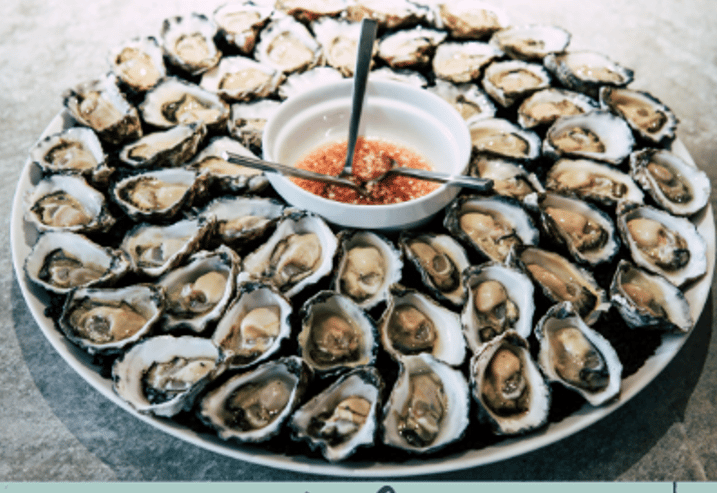Oysters the gems of the Ocean
Oysters. They may not seem like much at first glance, yet people eat almost 2 billion of them annually because they are so delicious. This is partly attributable to the countless oyster festivals and shucking competitions that are held throughout the world. There is always something new to learn about this common mollusk, whether you are just discovering oysters or a seasoned aficionado. Ten amazing facts about oysters have been compiled by us in an effort to shed some light on these remarkable mollusks.
Oyster: The Unique Anatomy
Oysters have a three-chambered heart, which is a feature shared by most reptiles and amphibians. That's not all, though. Hemolymph, an alternative to colourless blood that is pumped by this heart to a pair of clear kidneys for purification Oysters, as was previously noted, have gills that they use to breathe and feed on microorganisms that are circulating in the water surrounding them. Even the way in which their shells are fashioned is distinctive since it is moulded by the reef bed they are growing in.
Oysters: Healthy Option
How many foods can you name as both delectable and nutritious? Surprisingly, oysters have a balanced nutritional profile and are an excellent source of ascorbic acid, thiamine, riboflavin, and vitamins A and D. The daily required consumption of iron, copper, iodine, magnesium, calcium, zinc, manganese, and phosphorus for adults is more than met by consuming just six of them. They are safe to consume when pregnant and can even be given to your dog if properly cooked!
Oysters: Excellent at Cleaning Water
When it comes to water filtration, oysters are just amazing. Every day, adults can filter as much water as a small bathtub! That is equivalent to 1.5 gallons of water every hour. They achieve this by "filter feeding" on phytoplankton and tiny pieces of algae in the water nearby using their gills—yes, they have gills. A healthy oyster reef covering one acre can filter enough water in a single day to fill about 36 Olympic-sized swimming pools.
Oysters:Cool Compared to Wine
Oysters have a diverse range of flavour qualities, just like great wine. Despite coming from the same species as the majority of American oysters, their flavour and name are actually a result of their habitat. This relates to how much water they filter. Oysters from the Gulf Coast typically taste different from those from the Chesapeake Bay due to the variable levels of salt and types of nutrients in the various bodies of water.
Oysters: Produce Pearls (Not All)
When you open your next oyster, you probably won't find a pearl, which is unfortunate. Why? Because pearl oysters are from the family Pteriidae and can be found deep in the ocean, but edible oysters are from the family Ostreidae and are typically found on the top of the water. Additionally, the majority of pearls of jewelry-quality are grown in those non-edible oysters, clams, and mussels.
Oysters: Shells Help Plants Grow
Hold off on throwing those shells away just yet! To assist create nutrient-rich soil, your used oyster shells can be cooked, split up into little pieces, and used to your garden or compost. The high calcium content in the shells can create a pH level that is balanced, which can result in better produce and larger, more vibrant flowers. However, because the cracked shells can be very sharp, be careful where you put them so that you don't risk injuring yourself.
Early New York was an Oyster Hub
In the 17th century, Dutch settlers discovered a bustling oyster industry surrounding the island of Manhattan, which at the time was home to about half of the world's oyster population. Oysters and other shellfish were staple foods for the Lenape and other local indigenous people. So much so that it is said that the waterways were lined with enormous mounds of shells (and even pearls). Oyster "middens" scattered across the city serve as archaeological proof of this.
Oysters:Eaten Year Round
If you've ever eaten oysters, you've probably heard the saying that you shouldn't consume them during the months that don't begin with the letter "r." Prior to the development of refrigeration, it was more difficult to keep oysters chilled and fresh during the summer months (May, June, July, and August). Oysters can now be safely consumed all year long because to advancements in agriculture and technology.
Oysters: Have Been Eating for Thousands of Years
Did you know that although approximately 2 billion oysters are consumed annually today, humans have been ingesting the mollusc in large quantities since the prehistoric era? In actuality, oyster farming began in Japan at least 2000 BC, although the Chinese were the first to produce oysters in ponds. Oysters were a favourite food of the Roman Empire. The first significant oyster farmer is thought to have been Sergius Orata of the Roman Republic, who created a sophisticated technique to regulate the tides.
Oyster: Reefs Serve Many Purposes
In addition to serving as a habitat for other marine creatures, reefs also act as a natural sea wall alternative by assisting in the dispersal of storm and strong tide energy. This safeguards estuary waters, where the tide meets the stream at the mouth of a large river, which serve as a breeding ground for different sorts of marine life, while also protecting the coastline from erosion, flooding, and property damage. The current generation of oysters will be raised on reefs made from repurposed old oyster shells.
Ulhas Chaudhari
www.lifethicss.com




